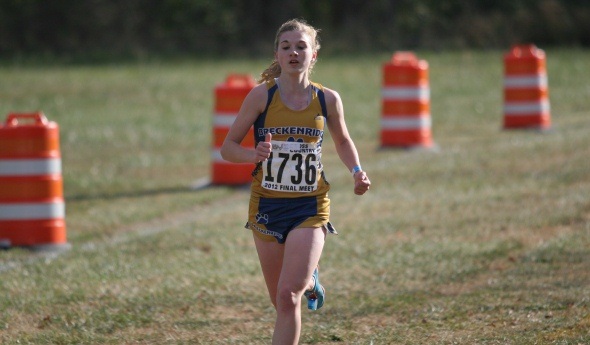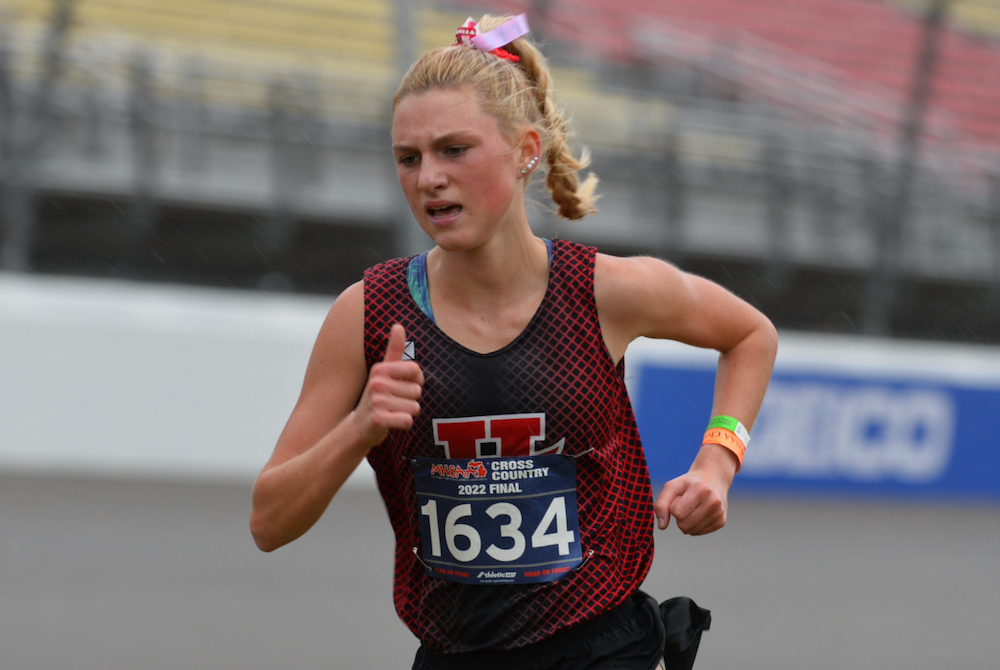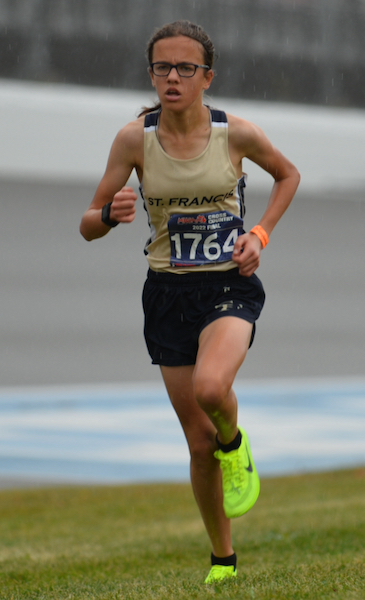
Olling Irons Out Health, Wins Again
November 3, 2012
By Bill Khan
Special to Second Half
BROOKLYN — Kirsten Olling couldn’t understand why the fast times she was running all summer weren’t translating to the cross country course in the fall.
The Breckenridge junior, whose personal best of 17:17.54 was set in last year’s Regionals, failed to break 18:06 in her first five races of the year and barely dipped below 18 minutes only three times all season.
A visit to the doctor three weeks before she was set to defend her title in the MHSAA Lower Peninsula Division 4 meet revealed an iron deficiency, which was quickly corrected with an iron supplement and a diet of hamburgers.
With the problem corrected, Olling won her third straight championship Saturday at Michigan International Speedway with a time of 17:59.6.
“A lot of coaches thought I had (an iron deficiency) at the beginning of the year, but nobody really said anything,” Olling said. “They just figured I was having bad days.”
Frustration began to mount for Olling, who figured she was ready for a huge season after running well all summer.
“I was really upset,” she said. “This summer during road races, I’d be running 17:17, 17:20s consistently. I was like, ‘Oh, yes, this should be like the best cross country season.’ No, I jinxed it. So, I’m never going to say, ‘It’s going to be the best cross country season ever.’ You’re going to jinx it.”
With her health turned around, Olling had to only tackle the mental side of running. Even having two MHSAA championships to her credit didn’t completely calm her nerves entering Saturday’s race as she won by 22.1 seconds over runner-up Holly Bullough of Traverse City St. Francis. Tessa Fornari of Waterford Our Lady of the Lakes was third in 18:38.8.
“I was actually worried I was going to lose it,” said Olling, who was never threatened Saturday. “I was really worried today.”
One of the mental tricks Olling used to push herself was basically to have teammates lie to her during the race.
“I told everybody to tell me someone’s right behind me,” Olling said. “That way when they tell me that, I’ll go faster. I had four different teams tell me that. They made me run faster.”
Homer, which made the top 10 for the first time with a sixth-place finish last season, won the team championship by a 118-142 margin over Bear Lake.
Homer placed three girls in top-30 all-state positions, with sophomore Jessica Reagle taking ninth in 19:26.3, sophomore Bailey Manis 19th in 19:59.6 and junior Amanda Reagle 23rd in 20:04.9. Rounding out the scoring were freshman Kayla Kline (45th, 20:37.3) and senior Johnica March (70th, 21:01.4).
PHOTO: Breckenridge's Kristen Olling leads the pack again on the way to her third MHSAA championship. (Click to see more from RunMichigan.com.)

Jazwinski Brings Hart Individual Title as St. Francis Moves to Front of Team Pack
November 5, 2022
BROOKLYN – Cross country races can be won between the ears before runners ever step foot onto the course.
Attitudes were tested as rain began to descend on Michigan International Speedway and the wind picked up just before the start of the MHSAA Lower Peninsula Division 3 girls race late Saturday morning.
Hart sophomore Jessica Jazwinski was loving life as she prepared to race.
“As a distance runner, I really try to love the wind,” she said. “Distance running and cross country is just a tough sport. The wind just adds to it — and the rain, too. It’s super fun.
“I was just thinking these conditions are just gonna feed my great race. This is real cross country. Yeah!”
Jazwinski overcame the elements to run the fifth-fastest Division 3 time ever, winning with a time of 17:36.70. She has two of the top-five times in Division 3 Finals history, having run 17:31.4 to place third last year.
“Today my race plan was just to go out hard and try to hold on to my pace,” she said. “I feel like I tried to race a lot like Steve Prefontaine, just go out and hold on.”
 Lansing Catholic senior Hannah Pricco was second in 18:17.59, Onsted sophomore Emmry Ross was third in 18:20.96 and Hart junior Alyson Ens was fourth in 18:28.52.
Lansing Catholic senior Hannah Pricco was second in 18:17.59, Onsted sophomore Emmry Ross was third in 18:20.96 and Hart junior Alyson Ens was fourth in 18:28.52.
“I love having great teammates to work with and encourage each other,” Jazwinski said. “We really try to encourage each other so much throughout the races. Throughout this year, some races she’s been a minute behind me, some races she’s been five seconds. I don’t want her to ever beat me, so that pushes me so much. I know she’s trying to race me and get up there with me.”
The only downer for Hart was having its string of Division 3 championships end at five with a fourth-place finish. Hart had two runners in the top four, but its No. 3 runner was 68th.
“I would totally trade my individual title for a team title,” Jazwinski said.
Traverse City St. Francis emerged from a close battle to win its first title since 2016 with 134 points. Pewamo-Westphalia was second with 142 and Lansing Catholic third with 165.
Sophomore Betsy Skendzel led St. Francis, placing seventh in 18:48.33. Completing the team score were senior Sophia Rhein in 26th (19:43.27), sophomore Grace Slocum in 33rd (20:07.95), junior Rylee Duffing in 60th (20:44.82) and junior Margot Hagerty in 63rd (20:45.78).
Lansing Catholic had three place in the top 10, but didn’t get another finisher until 103rd.
PHOTOS (Top) Hart’s Jessica Jazwinski pushes toward the finish during Saturday’s LPD3 Final. (Middle) Traverse City St. Francis’ Betsy Skendzel leads the way for the eventual team champion. (Click for more from Dave McCauley/RunMichigan.com.)

